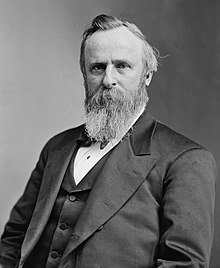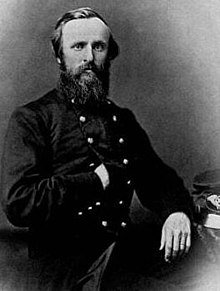Rutherford B. Hayes
Rutherford Birchard Hayes (born October 4, 1822 in Delaware , Ohio , † January 17, 1893 in Fremont , Ohio) was an American politician ( Republican Party ) and from March 4, 1877 to March 4, 1881 the 19th President of the United States . He also served twice as governor of the state of Ohio.
Early years and political advancement
Hayes' father, Rutherford Hayes, Jr, died of a fever in July 1822 before giving birth to his son in October. Originally from Vermont , he came from a Presbyterian family who immigrated to Connecticut from Scotland in 1625 . Rutherford Hayes, Jr and his brother-in-law ran a store in Dummerston until 1817 before moving to Delaware, Ohio. Here he worked as a farmer, trader and, despite his Presbyterian beliefs, as an investor in a distillery . Hayes' mother, Sophia Birchard, came from New England like the father . Her paternal ancestors had migrated from England to the Thirteen Colonies in 1634 . After the death of her husband, she inherited some land near Delaware and an unfinished house in the village, the construction of which was not completed until six years later. The future president was named after his parents, so Rutherford Birchard Hayes. Hayes had an older sister and a brother who drowned in 1825. The mother's cousin and her brother, the businessman and banker Sardis Birchard, also lived in the household. He became a father figure of Hayes, took care of his education and supported him financially, even after he moved to Fremont in 1827 . The main income of the family was the rental income from the farmed land.
Rutherford B. Hayes attended Isaac Webbs Preperatory School in Middletown , Connecticut between 1837 and 1838 . From 1838 to 1842 he studied at Kenyion College in Gambier , Ohio. After a brief stint in the Thomas Sparrow law firm in Columbus , he studied law at Harvard University . There he made his law exam in 1845. In the same year he was admitted to the bar. Between 1845 and 1861 he worked as a lawyer in Fremont and Cincinnati .
Originally, Hayes was a member of the Whigs . After that party disbanded in the mid-1850s, Hayes turned to the new Republican Party. Hayes became one of the pioneers of the new Ohio party. One of his reasons for joining the Republicans was his aversion to slavery . In 1857 he became an attorney for the City of Cincinnati. In 1860 he supported Abraham Lincoln's presidential campaign . When the civil war broke out , he joined the Union Army . There he served intermittently with William McKinley , who would later also become Governor of Ohio and President of the United States, in one unit. Hayes took u. a. in the Battle of South Mountain on September 14, 1862. In the course of the war he rose from major to major general . Between March 4, 1865 and July 20, 1867, Hayes represented the State of Ohio in the US House of Representatives . After he was nominated by his party as a candidate for the gubernatorial elections of 1867, he resigned from his seat in Congress.
Governor of ohio
After his victory in the gubernatorial elections, Hayes took up his new office on January 13, 1868. After re-election in 1869, he could remain in office until January 8, 1872. In 1875 he was re-elected governor. This term began on January 10, 1876 and ended on March 2, 1877 with his resignation, shortly before his inauguration as US President. As governor of Ohio, he managed to reduce the national debt. During his tenure, the Agricultural and Mechanical College was founded. An orphanage for children of military personnel was also built. Hayes campaigned for the registration of eligible voters; he was in favor of state regulation of the railways and better safety laws in mining. Conditions in prisons and hospitals should also be improved. In terms of monetary policy, he believed that hard money should be given preference over banknotes. In 1872 he supported the presidential campaign of Ulysses S. Grant , although he was personally deterred by the corruption in his government and did not consider Grant himself a great statesman.
Republican Party presidential candidate
As early as March 1876, Hayes was under discussion as a possible candidate for the presidency. He was considered politically unencumbered and was not involved in scandals. Nevertheless, Hayes did not believe that he could assert himself against well-known competition in his own party. At the Republican National Convention in June 1876, however, he received the necessary majority of votes in the seventh ballot to be nominated as a top candidate. His running mate as a candidate for the vice presidency was Congressman William A. Wheeler .
Controversial election results in 1876
The 1876 presidential election was not decided immediately. Hayes' Democratic Party challenger , Samuel J. Tilden of New York , won the majority of the vote in the country; however, there were significant discrepancies in four states, especially in Florida . To clarify the result, Congress set up a commission, which was dominated by the Republicans and awarded the victory in all four states to Hayes: of 15 members, eight voted for Hayes and seven for Tilden, exactly according to party support. The Democrats weren't happy with that and there were increasingly louder threats like Tilden or Blood! ("Tilden or blood!"). Ultimately, Tilden gave in after the Republicans had promised him in the unofficial compromise of 1877, among other things, to end the military occupation of the south by Union troops. That meant the end of Reconstruction . After several months, the final result of the presidential election was only known two days before the new term of office began.
President of the United States
To prevent a feared coup, Hayes was sworn in closed on March 4, 1877 in the Red Room of the White House. The swearing-in ceremony for the 19th President was not repeated in public until two days later. On March 6, he presented his new cabinet , which included the liberal Carl Schurz as interior minister. With David M. Key as post office minister, a former Confederate entered a cabinet for the first time. Hayes took action against the administrative corruption that had existed since the Grant administration. He also messed with some Republican party friends who had built their own house power through illegal methods. This also included Roscoe Conkling in New York. Hayes kept the promise made and ended the military occupation of the southern states . This measure was controversial at the time, but helped the economy of the south to get back on its feet. On the other hand, the whites in the southern states were able to regain their old position of power, if not with the help of slavery. To this end, laws regarding racial segregation were enacted, which upheld the principle of Separate but equal . This principle was expressly recognized as legal by the Supreme Federal Court in 1896. With the help of poll tax , many blacks were excluded from their right to vote. Although Hayes, as Republican President, had campaigned for a compromise with the South and ended the Reconstruction, the South remained closed to the Republicans. No Republican presidential candidate was to receive an electoral vote from the south by 1920.
In the summer of 1877, railroad workers went on strike in several states. Some of these escalated into violence; in Pittsburgh clashes left 20 dead and many injured. The governors of Pennsylvania , Maryland , West Virginia, and Illinois requested military assistance to restore order. President Hayes complied with this request and sent the army to put down the unrest. In terms of foreign policy, there were no significant events during Hayes' four years in office. Minor problems on the Mexican border were resolved peacefully. The plan of a French company to build a canal through Panama met with rejection in Washington. Since the project failed for financial reasons anyway, there were no further consequences. Immigration from China was another issue that caused problems, especially on the American west coast. Hayes complied with the wishes of the white population by changing a treaty that had existed since 1868 so that the US could regulate the immigration quota from China. In addition, after the Triple Alliance War, he settled a border dispute between Argentina and Paraguay in favor of Paraguay, which is why a Paraguayan department , the Department Presidente Hayes , was named after him.
Rutherford B. Hayes was the first President to officially tour the West Coast and use the phone during his tenure. At the instigation of his wife, he banned alcohol and tobacco from the White House . Lucy Hayes was then mocked as Lemonade Lucy . She also introduced the tradition of rolling Easter eggs in the White House garden.
Another résumé
As he had already announced when he was elected, Hayes was not aiming for a second term. On March 4, 1881, he left office. James A. Garfield was his successor . He then retired to his Spiegel Grove country estate in Fremont. Here he spent a lot of time in his library, got involved in educational projects and campaigned for prison reform. Hayes died there of a heart attack on January 17, 1893 . He had eight children with his wife, Lucy.
literature
- Ulrike Skorsetz: Rutherford B. Hayes (1877–1881): The end of the reconstruction. In: Christof Mauch (ed.): The American Presidents: 44 historical portraits from George Washington to Barack Obama. 6th, continued and updated edition. Beck, Munich 2013, ISBN 978-3-406-58742-9 , pp. 213-218.
- Hans L. Trefousse: Rutherford B. Hayes. (= The American Presidents Series . Ed. By Arthur M. Schlesinger , Sean Wilentz . The 19th President ). Times Books, New York 2002, ISBN 0-8050-6908-9 .
- Ari Arthur Hoogenboom: Rutherford B. Hayes: Warrior and President. University Press of Kansas, Lawrence 1995, ISBN 0-7006-0641-6 .
- Ari Arthur Hoogenboom: The presidency of Rutherford B. Hayes. University Press of Kansas, Lawrence 1988, ISBN 0-7006-0338-7 .
Web links
- Rutherford B. Hayes in the Biographical Directory of the United States Congress (English)
- American President Rutherford B. Hayes (1822-1893) , Miller Center of Public Affairs of the University of Virginia (English, editor: Ari Hoogenboom)
- The American Presidency Project: Rutherford B. Hayes. University of California, Santa Barbara database ofspeeches and other documents from all American presidents
- Rutherford Hayes in the National Governors Association (English)
- Rutherford B. Hayes in nndb (English)
- The administration of the President Rutherford B. Hayes , in Rudolf Doehn : Contributions to the history of the North American Union (1881), pp. 224–284
- Rutherford Hays in the Ohio History Connection Archives
- Life Portrait of Rutherford B. Hayes on C-SPAN , July 19, 1999, 148 minutes (English-language documentation and discussion with historians Thomas “Tom” J. Culbertson and Ari Hoogenboom as well as guided tour of the Rutherford B. Hayes Presidential Center )
- Rutherford B. Hayes in the database of Find a Grave (English)
Individual evidence
- ↑ Hans L. Trefousse: Rutherford B. Hayes. P. 3f .
- ^ Ester Singleton: The story of the White House, Volume 2 1907 (accessed August 16, 2012).
| personal data | |
|---|---|
| SURNAME | Hayes, Rutherford B. |
| ALTERNATIVE NAMES | Hayes, Rutherford Birchard (full name) |
| BRIEF DESCRIPTION | American politician, 19th President of the USA (1877–1881) |
| DATE OF BIRTH | October 4, 1822 |
| PLACE OF BIRTH | Delaware , Ohio |
| DATE OF DEATH | January 17, 1893 |
| Place of death | Fremont , Ohio |





